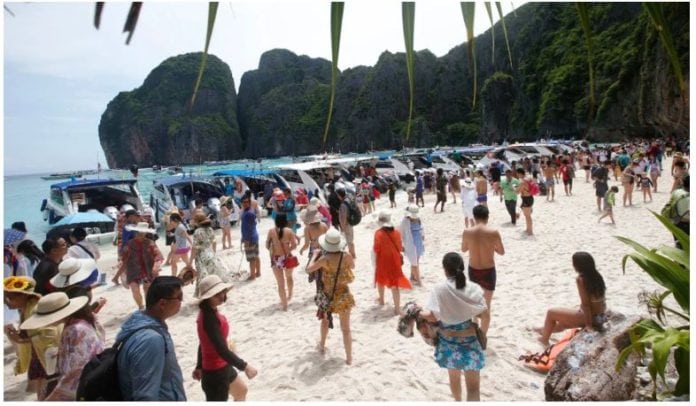Tourism and fame ruined Thailand’s pristine BEACH
In the 2000 Leonardo DiCaprio movie “The Beach,” the eponymous Thai destination is a sought-after, stunning blue cove, prized as much for its pristine waters as its secrecy. Few are aware of it; those who are keep its location on the down-low.
Or at least they’re supposed to.
Ironically, it is because of this movie that today the situation is quite the opposite.
After “The Beach” was released, two decades ago, its real-life inspiration — Maya Bay on the small island of Ko Phi Phi Leh — became overrun with tourists.
Up to 5,000 visitors a day swarmed by the boatload on day-trip junkets from the nearby hot spots of Phuket or Koh Phi Phi.
For a place as small as Maya Bay, that number packed a punch. Last summer, in an attempt to salvage the island’s marine ecosystem and give coral time to recover from decades of destruction, the island was shut to tourists.
Originally the closure was to take place only from June to September, during Thailand’s low season. But this summer, Songtam Suksawang, director of Thailand’s National Parks Department, announced that the bay will be off-limits to tourists until at least June 2021.
“We will review again then if it is ready to open to tourists,” Suksawang told CNN Travel. “We need more time to allow nature to fully recover. Our team will reassess the situation every three months.”
The closure of Maya Bay, one of Thailand’s most famous attractions, follows the temporary closure of the popular Koh Khai islands and Koh Tachai, both also due to overcrowding.
“Thanks to its beauty, Koh Tachai has become a popular tourist site for both Thai and foreign tourists,” Tunya Netithammakul, director general of the Department of National Parks, Wildlife and Plants Conservation, told the Bangkok Post in 2016.
“We have to close it to allow the rehabilitation of the environment both on the island and in the sea without being disturbed by tourism activities before the damage is beyond repair.”
Thailand’s recent heat wave. That mercury rise caused the sea temperature to increase, too, resulting in some bleaching.
The extra time closed to tourists will give the coral time to recover.
Suksawang tells CNN Travel that the closure will also allow for expansion of the island’s visitor facilities.
Plans include a new floating dock, an eco-focused boardwalk and new washrooms. In addition, an electronic ticketing system is being developed to limit visitor numbers to 1,200 people per day spread over four blocks of time.
“Our aim is to achieve sustainable tourism,” says Suksawang. “We want to pass on this natural heritage to our next generations.”





